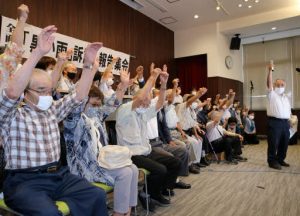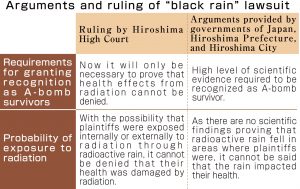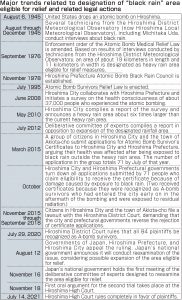Aging “black rain” plaintiffs seek quick settlement amid frustration
Jul. 15, 2021
by Daisuke Neishi, Staff Writer
Since being exposed to “black rain,” those who have long suffered negative health effects were once again jubilant even prior to August 6 this year, the 76th anniversary of the atomic bombing. On July 14, in a lawsuit involving radioactive black rain that fell in the aftermath of the atomic bombing, the Hiroshima High Court rejected a legal appeal made by the defendants including Japan’s national government and upheld the Hiroshima District Court’s original ruling, made in July last year, that had recognized all 84 plaintiffs as A-bomb survivors. Lawyers hailed the decision as a landmark ruling because the court also demonstrated its judgment to expand the current framework of requirements for granting recognition to people as A-bomb survivors. The aging plaintiffs in the case strongly urged the governments of Japan, Hiroshima Prefecture, and Hiroshima City to not appeal the case to Japan’s Supreme Court, indicating their desire to reach a comprehensive settlement as soon as possible.
“The appeal is hereby dismissed.” The voice of Presiding Judge Kazuto Nishii resounded in courtroom No. 304 of the Hiroshima High Court at 3:00 p.m. that day. Immediately thereafter, supporters held up a sign with the phrasing “Complete victory” as they shared their joy in front of the courthouse. With a deeply emotional expression, Masaaki Takano, 83, head of the plaintiff group and resident of Hiroshima’s Saeki Ward, said, “The court acknowledged we were telling the truth.”
After the ruling was handed down, a meeting designed to report the judgment was held at the Hiroshima Bar Association Hall, near the high court’s courthouse. With about 150 people in attendance, including the plaintiffs, lawyers, and supporters, attorney Masahiro Takemori stressed the significance of the ruling this time. “This second ruling was a landmark decision, as it reinforced the original ruling and urged the government to fundamentally review how it handles relief for A-bomb survivors,” Mr. Takemori said.
The high court ruled it was undeniable that the health of the plaintiffs had been damaged by exposure to black rain. In contrast to the earlier district court’s ruling, which conditioned A-bomb survivor recognition on the development of one or more of 11 diseases such as cancer, the ruling this time revealed a new framework that could provide relief even to those without the designated diseases.
Megu Otaki, professor emeritus at Hiroshima University and expert in the field of internal radiation exposure, participated in the meeting explaining the court decision. On the ruling, Mr. Otaki gave his assessment. “In consideration of the fact that the effects of internal exposure to people’s health are unknown scientifically, the court demonstrated that aid should be provided more broadly to people who also were potentially exposed. The ruling will lead to elimination of the situation in which those who have long suffered health effects caused by exposure to black rain failed to receive relief.”
Responding to the district court’s earlier decision, Japan’s national government formed a deliberative committee of experts in November last year to review the possibility of expanding the designated area for provision of relief measures. The committee has announced its intent to release an interim report sometime this month, but the report’s specifics are unclear at this point.
“Many people died in agony,” said Seiji Takato, 80, one of the plaintiffs and a resident of Hiroshima’s Saeki Ward, in a voice tinged with bitterness. Since the lawsuit was filed in 2015, more than 10 plaintiffs have died. Mr. Takato said he feels both pleasure from winning the lawsuit as well as frustration. “This trial was not just for the plaintiffs. Many others who have been exposed to black rain are watching.”
On July 15, the plaintiffs plan to demand that the city and prefectural governments not appeal the court ruling to the Supreme Court. With their hope that the trial ends now, the plaintiffs believe their message will be understood this time.
Based on aversion to appeal ruling, Hiroshima Prefecture will request that national government give up pursuit of case
The Hiroshima High Court’s ruling on July 14 acknowledged damages caused by black rain and ordered the governments to issue Atomic Bomb Survivor’s Certificates to all 84 plaintiffs. As defendants, the Hiroshima City and Japanese national governments did not make definitive comments on their future response including about a final appeal but did state simply they would discuss the issue with relevant parties. On the contrary, Hiroshima Prefectural Governor Hidehiko Yuzaki noted that, “The desperate wish of the plaintiffs was accepted by the court. From the prefecture’s perspective, we don’t desire to make any legal appeals to the Supreme Court.” Mr. Yuzaki indicated he would call on the national government to abandon any final legal appeals.
At the prefectural offices, Mr. Yuzaki gave his assessment of the decision that ruled completely in favor of the plaintiffs, following the district court’s original ruling. “It is of a great significance that the high court also accepted the desperate wishes of those who have suffered since their exposure to black rain.” With respect to those who have experienced ill health after the exposure, he asserted they should be recognized as A-bomb survivors and be eligible to receive relief measures so long as their arguments are rational and reasonable.
The Hiroshima City and Prefectural governments, which were defendants in the trial, will not be given room for discretion about the system design for issuance of survivor’s certificates, because their role is limited to issuing the certificates to survivors on behalf of Japan’s national government. Mr. Yuzaki also revealed his stance about recommending to the Ministry of Health, Labour and Welfare (MHLW) that the organization should give up on making any final legal appeals saying, “We want to convey our intent in some way.” However, the governor stated that the prefecture’s final action would be determined after discussions are carried out with MHLW and the Hiroshima City government.
In Hiroshima City Mayor Kazumi Matsui’s comments, he indicated that, “The ardent wishes of those who experienced black rain and have shouldered physical and mental burdens were acknowledged by the court, following the original ruling.” As for the city’s future action against the ruling, Mr. Matsui explained, “We will participate in deliberations with the prefectural government and MHLW based on our stance of aiming at expansion of the rainfall area.”
In a press conference held after the ruling announcement, Chief Cabinet Secretary Katsunobu Kato, said, “The Japanese government’s assertion wasn’t accepted. In the near future, details of the ruling will be thoroughly examined together with the relevant government ministries, and we will then respond after discussing the issues with the prefecture and the city.”
Mr. Kato also mentioned a deliberative committee of experts designed to reexamine the area eligible for relief. “What we need to do is not only identify a solution by gathering appropriate scientific data but also to work in consideration of the fact that not much time is left for the aging people in the case.”
When asked about what point of the argument made by the national government was not accepted in the high court’s ruling, Hiroyuki Ishii, Senior Coordinator of the General Affairs Division of MHLW’s Health Service Bureau repeated, “We cannot answer the question at present, as we are in the process of scrutinizing the ruling.”
(Originally published on July 15, 2021)









